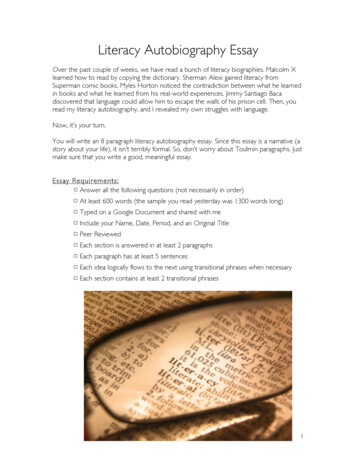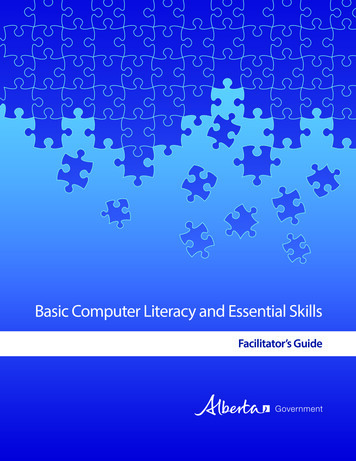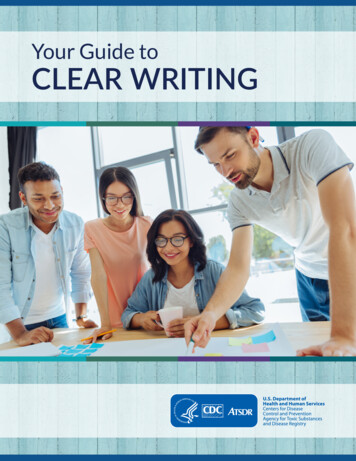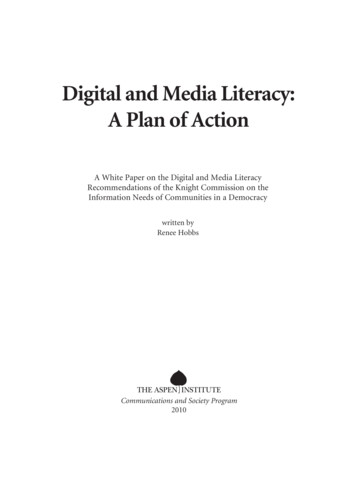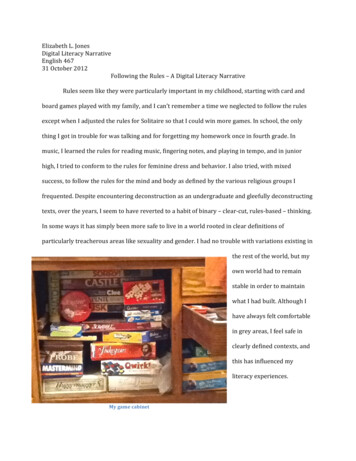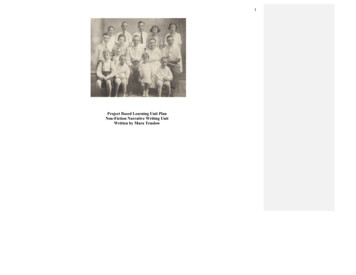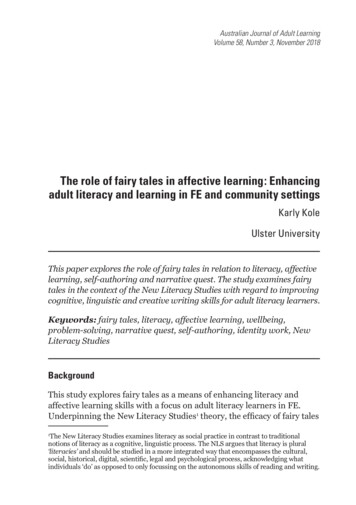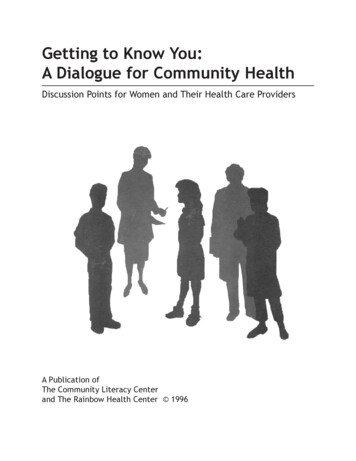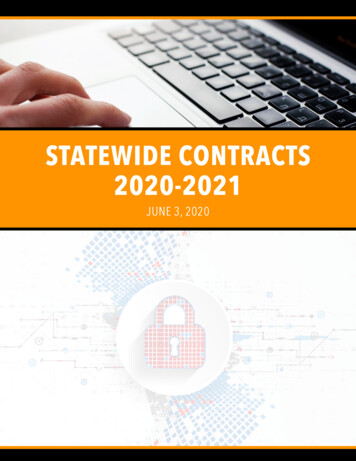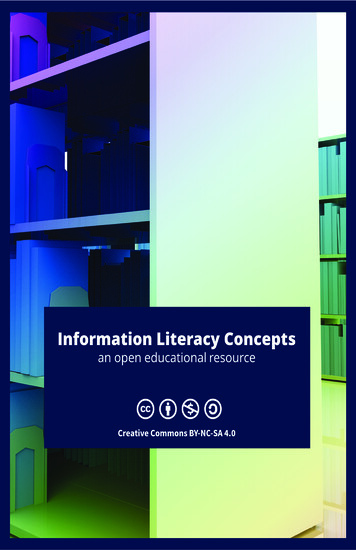
Transcription
Information LiteracyConceptsAn Open Educational Resource
2017 Joyner Library, ECU.Information Literacy Concepts:An Open Educational Resourceby David Hisle and Katy WebbAttribution-NonCommercial-ShareAlike 4.0 International (CC BYNC-SA 4.0)A fully editable copy of this resource is available under the abovelicense at:https://libguides.ecu.edu/libinstruction2
INFORMATION LITERACY CONCEPTSInformation LiteracyConceptsAn Open Educational Resourceby David Hisle and Katy Webb3
Table of ContentsIntroduction:What is Information Literacy?CHAPTER ONE:How Libraries WorkCHAPTER TWO:What’s Credible Anymore? Fake News and evaluating theinformation you encounter during your researchCHAPTER THREE:The Information Landscape: an Overview of informationtypes and when they appear in publicationCHAPTER FOUR:Navigating the Information Landscape: Search Engines,Library Databases, Library of Congress Classification, andDiscovery ToolsCHAPTER FIVE:The Research Process: Settling on a topic, identifying keywords, and retrieving the information you needCHAPTER SIX:The Ethical Use of Information: About academic integrity,avoiding plagiarism, and scholarship as a conversationGLOSSARY4
INFORMATION LITERACY CONCEPTSINTRODUCTION:What is information literacy?What is information literacy and what does it mean tobe information literate? The American Library Associationdefines information literacy as a set of abilities empoweringindividuals to recognize when information is needed and tobe able to locate it, evaluate it, and use it effectively. Whileinformation literacy is often talked about on college campusesin terms of doing library research for papers and annotatedbibliographies and other sorts of classroom assignments,we use and need information in every aspect of our lives.Think about all of the informal research we do eachday. We look up movie and book reviews, how-to videoson YouTube, product reviews, and strategies for parenting.We Google how to fill out some field on our tax forms, welook up job ads and tips on job interviews, how to spell or5
define some unfamiliar word or acronym. We all have information needs, and being able to effectively identify andmeet those needs is at the core information literacy. Beingable to differentiate quality information from questionableinformation is also critical. Is that shocking article your sisterposted on social media actually true? What about healthadvice offered by a friend? What about some surprisingstatistic you heard cited by a politician or political candidate?The American Library Association asks to think aboutinformation literacy in six ways.1. Authority Is Constructed and ContextualWhen you use information, or choose one source of information over another, you presume a certain amount ofexpertise on the part of the information’s author on the topicthey are writing about. What gives the author that authority?What makes some information more authoritative than otherinformation? What makes a piece of information authoritative can vary from discipline to discipline and be based oncontext. So for example, an author may be an authority ona given topic because of extensive experience, or becauseof extensive education. Even without deep experience oreducation, an author may bring authority to their writingbased on their having witnessed or participated in somemajor event. In both cases, their authority is contextual. Aphysics professor may have authority when writing withintheir field, but be considered far less authoritative whenwriting in an unrelated field.6
INFORMATION LITERACY CONCEPTS2. Information Creation as a ProcessInformation appears in a variety of forms. Depending onwhether it is in the form of a newspaper article, a scholarlybook, or a formatted report, the creation of informationrequires a process. Understanding how and why authorspublish in a particular format, what those formats requirein terms of fact checking, or sourcing, or expertise, whateditorial oversight exists, the role of publishers—all theseconsiderations may play into your thinking about the relevance of a particular information source to your researchquestion.3. Information Has ValueInformation has value, and this fact has very real implications to researchers and information consumers in both howinformation is produced and how it is disseminated. It haseconomic value as a commodity, for example, as evidencedby intellectual property rights and other legal considerations,and by the considerable role of the publishing industry.Information also has educational and social value, with itsability to inform, educate, and persuade.4. Research as InquiryOne can think of research as an inquiry. A researcherasks a question, or identifies some gap in our current understanding of a topic, and in the process of filling that gap, newquestions and new avenues for further research emerge.7
5. Scholarship as ConversationScholarship on a given topic will grow and evolve overtime. New theories, new interpretations, new experiments,new facts are always being discovered and debated. As thereferences or citations of any scholarly article demonstrate,every researcher is building on the work of many other researchers. Conscientious scholars will always go to greateffort to indicate what previous work has informed their ownwork. College students are expected to adopt this practice aswell, citing the work that informs their own work and situating their ideas and theories within the larger conversationtaking place in their respective discipline.6. Searching as Strategic ExplorationOver time, as you gain experience and your research needsgrow more complex, you will likely develop sophisticatedstrategies for locating relevant information. Searching forinformation is rarely as simple as just plugging a keywordinto a search engine or library database and getting all thebooks and articles you need. You’ll likely try different waysof searching for information, and in different places. Youmay want to brainstorm, or talk to a librarian.The five chapters in this text each look at a different aspectof information literacy but will collectively provide you withan overview of those concepts most critical to navigatingtoday’s information environment. After each chapter youwill have the opportunity to test your understanding with abrief reflection. We begin by looking at the research process.8
INFORMATION LITERACY CONCEPTSCHAPTER ONE:How Libraries WorkWe can always benefit from knowing a little more abouthow our campus libraries operate. Understanding the different roles the library and librarians play on your campuscan help us to ask better informed questions and go deeperin our search for relevant and high quality information.Campus libraries are always changing to accommodate newtechnologies and the evolving needs of the students andfaculty who use them, but the core functions of librariesremain mostly unchanged.Access ServicesAccess Services is a major department in any library,though it will sometimes be called the circulation department. Access Services provides students with the means to9
access a library’s collections, meaning that they check booksin and out and maintain borrower records. These borrowerrecords, or library accounts, are usually only available toaccess services staff. In other words, if we have any questions about our library account, or want to check books inor out, or want to pay or contest a fine, Access Services iswho can help.Access Services may have other services as well. Coursereserves are usually kept here, as is the technology (cameras,microphones, laptops, etc.) that your library may loan out.ReferenceReference librarians assist students with locating relevantinformation for their projects. They can also (often) trackdown answers to especially challenging questions. Yourlibrary’s reference department will probably have a servicedesk where you can ask question and talk to librarians. Atsome libraries, the reference desk is combined with accessServices.Besides offering one-on-one assistance with research,reference librarians may also teach library instruction classeson your campus. If you are uncertain about the best placesto look for information on a given topic, ask a referencelibrarian. Typically academic libraries will have librarianswith specialized areas of expertise, so expect your libraryto have a business librarian, a STEM librarian, and so on.Special CollectionsMost large libraries will maintain special collections.These collections may be based on particular themes, often10
INFORMATION LITERACY CONCEPTSwith a focus on local history. Special collections are oftencomprised of primary documents. These primary sourcesmay be letters or old photographs, drafts of a poet’s works,or the correspondence of a notable scholar or politician.Technical and Discovery ServicesTechnical services largely refers to acquisitions and cataloging, with the former purchasing books and journals forthe library and the latter integrating them into the collection.You will rarely see these librarians, as they typically have nopublic service role, but they make up a big part of staff inany large library. The search (discovery) tools themselvesalso require time and staff to develop and maintain, soyour library will also have staff devoted to operating andimproving the library catalog interface and whatever otherlocal discovery tools are available for research.Services You Can ExpectYour library may have a print collection with thousandsor even millions of volumes--it may provide you with instantaccess to millions of electronic articles and books. But nolibrary owns every title. You may need some seminal workon your topic--or perhaps just the next book in a series youare reading for pleasure--that is not part of your local library’scollection. This does not mean that the item is unavailable toyou. Expect your library to have an interlibrary loan serviceto help fill in the inevitable gaps in its collections.Interlibrary loan services borrow the materials we needfrom other libraries and make them available to us. Somerequests can be filled quickly. For example, if you need an11
article, it may take only a day or two for the library to fillthe request. A book may take a week. Rare titles may takelonger. Some interlibrary loan programs are free of charge,others may require a small fee. Some programs will requestmedia on your behalf, while other may not. Your library’sinterlibrary loan program should have their policies clearlystated on their web site.Also expect your library to offer special programmingthroughout the year. This might include exhibits and displays,guest speakers and lecture series, workshops, or even examtime stress relievers. For example, game nights are popularat some libraries during exam periods. Other libraries mayoffer yoga, pet therapy events, or snacks.12
INFORMATION LITERACY CONCEPTSCHAPTER TWO:What’s Credible Anymore? Fake News andevaluating the information you encounterduring your researchFake News, Information Bubbles, and Filter BubblesWhether the agenda is to sway public opinion, to affectthe outcome of an election, or simply to make money, theproliferation of fake news creators and distributors hascomplicated our already complicated information environment. Perhaps as bad, “fake news” has become an easyway to dismiss stories and information we don’t like withoutaddressing the actual content of such stories.When you get your news primarily from one source orfrom one partisan perspective, you are operating in an information bubble. You encounter stories that confirm your13
view of the world and avoid stories that challenge thoseviews. Information bubbles have a natural appeal—theyprovide us with stories and perspectives that reinforce whatwe already believe about the world.Information bubbles happen naturally when we seekout news and news sources that align with our world views.This isn’t limited to politics and current events either. Theycan happen within professions and within organizationstoo. Social media can also create information bubbles, aslike-minded friends share articles they haven’t verified butthat conform to some preconceived idea of the world. Andonce a story has been shared enough times, “fake news” cantake on an unearned mantle of authority.Worse, “filter bubbles” are making it more difficult tostep outside of those information bubbles. Social mediaand search engines use algorithms to rank what appears inyour feeds and search results. These algorithms look at yourprevious engagement with social media posts and searchresults in order to provide you with content that aligns withyour interests. These sorts of tailored experiences online-whatever their virtues--limit our information gathering inways we can’t anticipate. The algorithms are always changingand usually closely guarded by the companies that createand implement them.This chapter outlines some strategies that you can useto evaluate particular sources of information and particulararticles you may encounter. But this is only part of the solution to separating truth from fiction in the information weencounter. Better information habits are required of us.14
INFORMATION LITERACY CONCEPTSUntil we apply skepticism and critical thought to the information that aligns with our world views just as we wouldfor information that challenges us, we set ourselves up tobe fooled by fake news. Until we expand our informationbubbles to include more perspectives and coverage from amore diverse community of scholars and reporters, we limitwhat we can know and learn about our world.Evaluating InformationBeing able to critically evaluate the information we encounter on the web is a hugely valuable research skill. Why?Because so much information can be found online, and noteverything we read is true. Sometimes information can benarrowly accurate, yet still be so biased, selective, or leadingas to make the information essentially useless for researchpurposes. Some information may have once been accurate,but is now simply be too out-of-date to be useful. Sometimes the authors of an article are not experts on what theyare writing about. And sometimes the problem is not theaccuracy of the information, it’s the lack of research-qualitydetail and substance.15
Being a critical consumer of information is helpful notonly in school, but also in our daily lives. Just as we need theinformation in our college papers to be based on reliable,quality sources, we also want the health advice, productreviews, and other kinds of information we personally useto be reliable.AccuracyHow do we really know that a given piece of informationis accurate? While there is no single rule that guarantees thecorrectness of the information in a given article or website,there are ways to increase your confidence that the information is factually correct.If statistics or quotes are provided in an article or on aweb page, does the author provide their source? Can thatstatistic or quote be verified by a reliable second source?If you encounter a quote, might that quote be overly selective or misleading? And can statistics be correct but stillmisleading?They can. Misleading graphs (or distorted graphs) arecommon online. Truncated graphs, while perfectly appropriate in many cases, are a particularly easy way to deceive.Let’s look at a quick example. The graph below shows ratherdramatic change across groups A through E.16
INFORMATION LITERACY CONCEPTSBut notice that the Y axis does not begin at 0. Instead itbegins with 9,100. If the Y axis did begin with 0, we wouldsee much less dramatic variation across the groups:Quality information sources will cite their statistical dataso that researchers can go to the original source and seethe data for themselves.17
Quotations can also be taken out of context, as in theexample below.“This would be the best of all possible worlds if therewere no religion in it.”-John AdamsThis quote has appeared on many websites and in articles, and it seems clear in meaning. So how could suchan unambiguous quote still deceive us? If we look at thefull context of the quote, which appeared in a letter Adamsonce wrote to Thomas Jefferson, it shows a very differentmeaning:“Twenty times, in the course of my late reading, haveI been on the point of breaking out, ‘this would be thebest of all possible worlds, if there were no religionin it!!!!’ But in this exclamation, I should have been asfanatical as Bryant or Cleverly. Without religion, thisworld would be something not fit to be mentioned inpublic company--I mean hell.”-John AdamsWhatever one thinks of Adam’s perspective, his viewsare clearly misrepresented in the original quote, despite itbeing taken word-for-word from his own writings.18
INFORMATION LITERACY CONCEPTSAuthorityWhen we quote from an author or article in a collegelevel research paper, we are presuming that the source insome way strengthens the argument we are trying to make,or provides some insight into our research question. Butthis requires that the sources we use have some kind ofauthority on our topics. And how to do you know that theydo? Why quote or cite an article we’ve discovered on theweb and not, say, the opinions of our parents or our friends?Our educations and life experiences provide each of uswith unique expertise, but not all expertise is relevant toa particular research question. A famed political scientistmay be an authority on game theory, for example, but thathardly qualifies him or her to conduct heart surgery, or drafttechnical drawings. The quality of your research very muchdepends on the authority of your sources, so it is importantwe learn what we can about the authors we cite and whatqualifies them to speak authoritatively on a given topic.When you evaluate an article or website for use in collegelevel research, consider these factors: What is the author or organization’s credentials? Are any credentials even provided? If not, why dothey deserve to be cited? Is the author qualified to write about this topic?What is their area of expertise? Is the author affiliated withan educational or research institution?19
ObjectivityWhen we talk about objectivity, we are largely talkingabout the author’s objectives in producing and publishingthe information. Why does the article or website exist? Whatare the biases of the authors or the organization behind theinformation? Bias isn’t necessarily bad. Just because an author or organization has a particular point of view does notmean that their information is inaccurate or lacks authority.The very reason that many groups exist is to advocate fora particular position, and to that end they often collect orgenerate a lot of high-quality research. That said, you willwant to be aware of the objectives of the authors or groups.And in order to write a well-rounded paper, you will likelywant to collect information from authoritative groups withdifferent perspectives as well. When all your informationcomes from just one side of a debate, your paper will lackbalance and perspective.20
INFORMATION LITERACY CONCEPTSDo note that all perspectives are not equally informedby relevant expertise. If you are presenting multiple perspectives in a paper, be sure that all those perspectives areinformed by authoritative sources.When considering objectivity, also pay close attention toadvertising that appears on a website. The purpose of somewebsites is to sell a particular product, not necessarily toeducate. While they may host articles as well, the articlesare basically just ads for the product. Even more insidious,companies may run elaborate advertisements on legitimatewebsites that are meant to look and read like normal articles,but are in fact just promotional materials. “Sponsored content” on legitimate news websites is increasingly common.These articles may be written by industry lobbyists or politicalpartisans and can appear alongside legitimate news stories.Often all that distinguishes “sponsored content” from realnews is a small, easily overlooked label. Do not be fooled.Ask yourself Is the information fact, opinion, or propaganda? Is the information well-researched? Is there a bibli-ography or citations or references at the end? Is the author objective and unbiased? Bias isn’talways disqualifying, but you will always want to be awareof what the author’s bias is.21
CurrencySome of your research projects may require very upto-date information. For example, if you are researchingpresent-day population statistics, you won’t want to use the1980 census figures. If you are writing about public sentiment on a hot-button social issue, old data is worse thanuseless--it may be downright deceptive. When we talk aboutcurrency, we’re talking about how current the information isin a book or article. For some projects and discipines olderinformation might be fine. But for many research topics,currency is a major consideration.Sometimes the only information available is a bit moreaged than is ideal. In those cases we make a judgementcall about whether to use it in our work. Often though, wecan track down more recent statistics with a little detectivework. For example, what is the source of the information?The US government is one popular source for statisticalinformation. If the government statistics you encounterin an article are dated, perhaps newer statistics have beenreleased since the article was published. Going to the information’s source is good first step.Ask yourself: When was the information published or produced?Will dated information still be relevant to my research project? With web-based articles, how many dead links ap-pear on the site? Does the site still receive regular updatesappropriate to the content?22
INFORMATION LITERACY CONCEPTSCoverageEarlier when we talked about objectivity, we also talkedabout bias. While bias is not inherently bad, you would notwant your total pool of resources to reflect the same bias.Otherwise you are only getting part of the picture. In part,this is what “coverage” asks: what part of the picture areyou getting with your information resource?Is the material presented at an appropriate level? Anarticle may contain correct information, but may lack thesort of depth of content necessary for research purposes.Does the resource add new information or does it simplycompile information easily found elsewhere? If the workmerely compiles the work of others, would those originalsources be more appropriate for use in your work?When considering accuracy, authority, objectivity, currency, and coverage, there are often no clear-cut answers.23
An article that may be appropriate for one kind of researchquestion may not be appropriate for another. Make deliberate, informed judgements, as the quality of your sourceswill greatly impact the overall quality of your work.24
INFORMATION LITERACY CONCEPTSCHAPTER THREE:The Information Landscape: an Overview ofinformation types and when they appear inpublicationStudents often encounter a checklist of different publication format requirements when they receive their firstmajor research assignment. They may be asked to use acertain number of books as sources, or a certain number ofscholarly journal articles; they may be asked to use severaldifferent formats for the same paper.Before starting on a research assignment, students maynot have thought much about these different kinds of sourcesand why each exists. Some formats will be relevant to oneresearch question but not others. Which are likely to be25
most useful to you will depend on both your assignmentrequirements and the nature of your research question. Let’slook briefly at the major formats you are likely to encounter.Scholarly JournalsScholarly journals are the gold standard when it comesto high-quality research sources and you will likely be askedagain and again to use scholarly journal articles as you movethrough your degree program. Scholarly journals go byother names. You may see them called academic journals,or peer-reviewed journals, or refereed journals, but theyall refer to the same thing. Here’s what you need to knowabout them.Researchers and scholars publish their work in scholarlyjournals. You may read about some new discovery or research study in a newspaper article, or see it covered by ascience reporter on cable news, but these sources are simplyreporting on what was originally published in a scholarlyjournal article.Because scholarship builds on earlier scholarship, it isessential to the community of researchers and scholarsthat their literature is as correct and rigorous as possible.To ensure that only quality articles are published, scholarsuse the process of peer-review.Let’s walk through an example:Jim Schultz is a professor of sociology. He recently completed a study of student groups on campus, and has writtenan article. Because scholarly journals can be very narrowlyfocused on highly specialized fields of study, Jim’s first step26
INFORMATION LITERACY CONCEPTSis to identify a journal that publishes the kind of researchhe has conducted. He may consult with a librarian or withcolleagues in order to identify promising journals.Jim investigates the formatting and citation style requiredby a promising journal, formats his paper accordingly, andsubmits his article for possible publication. The editor of thejournal reviews the article and determines that it could bea good fit for the journal. The research is within the mainstream of research in the field and it contributes originalknowledge to the field.The editor then sends the article to a small group ofscholars experienced with Jim’s kind of research. Thesescholars are anonymous and will go through the article witha fine toothed comb, scrutinizing the methodology of thestudy and making sure other aspects of the article (suchas its review of the existing literature and its discussion offindings) are of sufficient quality for publication. The reviewers make notes on where the article could be improved, onimportant citations missing from the literature review, andevery other aspect of the paper.Jim doesn’t know who his reviewers are, but he receivedtheir comments. From there he makes revisions to his workand resubmits the article to the journal. If this revised version of his article is accepted, his work will be published inthat journal.The peer-review process is the most rigorous processwe have for ensuring quality; it is also a major requirementfor most forms of faculty tenure. For both these reasons27
expect scholarly journals to loom large in your future research in college.Tip: most databases and discovery services will include a checkbox for scholarly or peer-reviewed journal articles. By checkingit off, you will only get scholarly articles in your search results.Trade and Popular PublicationsMany of us grew up reading magazines like Time orNewsweek. Whether at the grocery store or the newsstand,the overwhelming majority of the magazines we encounterare considered popular publications. This includes titlesranging from Popular Science to Rolling Stone. What makesthese titles popular? Briefly put, the business model of thesepublications depends on advertising dollars; how much thepublications can charge for advertising space depends inlarge part on the number of readers (i.e., how popular thetitle is with readers.)Plenty of experts and authorities write articles for popular publications. But it should already be apparent that themotivations of popular publishers are different than thoseof scholarly journals. The editors of popular magazinesdecide what to publish based at least in part on whetherthe content will sell more copies. Articles are fact-checked,but without the same scrutiny that peer-reviewed articlesundergo.Popular magazines can be perfectly adequate for somekinds of research, but expect to find them less and less usefulas research sources as you progress through your classes.28
INFORMATION LITERACY CONCEPTSThey simply lack the authority and coverage essential tocollege-level research.A second kind of magazine will likely be more useful-trade publications. Trade publications (sometimes calledtrade rags or trade magazines) are similar in many waysto popular magazines. They rely on advertising dollars tostay in business and they do not provide the same rigorouspeer-review process that scholarly journals do.The real difference between popular and trade publications is audience. Most popular titles are written for generalaudiences. This means that the language is at a relativelylow reading level and few technical terms are included.The publications presume their readers know little aboutthe content area. With trade publications, the audience isa particular industry or job field.An example of a trade publication is Advertising Age. Forthose in the advertising or publishing industries, Advertising Age is an important source of current information onthe state of the industry. The magazine presumes that thereader already has a good working knowledge of advertising, so the articles are more narrowly focused and likely toinclude industry-specific terminology and concepts.As a way to learn about a new job field, or to stay currenton new technologies and trends in your future professions,trade publications are an important go-to source.29
NewspapersNewspapers will probably not be a common source ofinformation for your college-level research papers. Newspaper articles are edited and fact-checked, but without thesame scrutiny as a peer-reviewed article. Newspaper articlestypically lack depth and background information. Their realvalue is in their immediacy. Newspapers provide currentcoverage of events and so can be helpful to us when ourresearch topics are historical in nature. We will have moreto say about the immediacy of newspaper articles later inthe chapter when we talk about the information time line.MonographsMonograph
books and articles you need. You’ll likely try different ways of searching for information, and in different places. You may want to brainstorm, or talk to a librarian. The five chapters in this text each look at a different aspect of in

